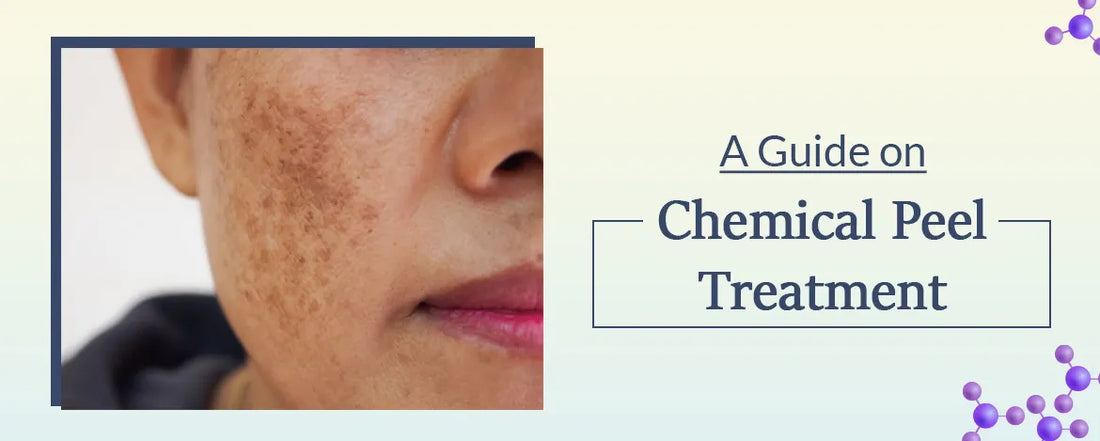
A Detailed Guide on Chemical Peel Treatment at-home
By: Sandip KumarAcne, sun exposure and ageing leave our skin with uneven texture, wrinkles, and dark spots. To make it look and feel smooth and young, people are now opting for chemical peel treatments. This treatment was traditionally provided at the dermatologist’s clinic but now brands are up with products that offer you the same benefits and strength of a chemical peeling done at a dermatologist’s office. Chemical peeling helps exfoliate the top layer of our skin that gets damaged due to sun exposure and damage caused by environmental factors.
In this blog, we will discuss chemical peeling in detail so you can make a better decision about the treatment.
Can we use chemical peeling on neck?
Chemical peeling, also known as derma peeling, is the least invasive way to improve skin’s appearance. Though these peels are usually used on the face, they can also be used on the neck and hands.
How do chemical peel treatments work?
In chemical peeling treatment, the outer layer of the skin is removed to reveal the soft, flawless skin below it. It helps stimulate collagen production in the skin’s dermal layer. The depth of the peel procedure depends on the chemical used, the length of time the chemical is allowed to remain on the skin, and how vigorously the solution is applied.
Chemical peel for acne
Oily skin is characterized by large pores, acne breakouts and stubborn dark spots post-inflammation. The best chemical peel for acne is the one that is infused with Salicylic Acids because salicylic acid penetrates through oil and pore lining to clear all blockages and prevent skin from breaking out.
Chemical peel for combination skin
Combination skin is characterized by pores and excessive oil production in the T-zone area i.e., forehead and nose. For combination skin, chemical peel with lactic, salicylic and glycolic acid would provide the best benefit because salicylic acid will clear out the pores and address breakouts; lactic and glycolic acid will work on the surface to exfoliate dead cells.
Chemical peeling for sensitive skin
People with sensitive skin experience redness and sensitivity. Lactic acid chemical peeling is ideal for this skin type because it is gentle on the skin.
Chemical peel for normal skin
Normal skin behaves differently in different seasons. In summers, it produces oil, mainly in the T-zone and in winters, it can feel dry and tight. For this skin type, chemical peel with mandelic, glycolic and lactic acid is the best.
FCL Penta Peel Pads for all skin types
FCL Penta Peel Pads is an easy-to-use, at-home chemical peel treatment enriched with 5 different actives that work wonders on all skin types. This innovative peel treatment is enriched with the following:
- Mandelic Acid
- Lactic Acid
- Salicylic Acid
- Hyaluronic Acid
- Phytic Acid
Benefits Of FCL Penta Peel Pads
Dermatologist-recommended chemical peeling treatment for people who need healthy and even-toned skin. And Penta Peel Pads offer all the below-listed benefits-
- It evens out skin tone as it reduces dark spots and discolouration.
- It smoothens skin texture by rejuvenating the skin.
- It controls acne breakouts as it regulates sebum production and removes dead skin cells and dirt.
- It improves the appearance of skin as it reduces signs of ageing and sun damage.
- It corrects post-inflammatory hyperpigmentation (PIH) caused due to conditions like acne, etc.
Who should use Penta Peel Pads?
This at-home chemical peeling pads can be used by people having skin concerns that include:
- Melasma
- Hyperpigmentation
- Fine lines and wrinkles
- Uneven skin tone or texture
- Sun-damaged skin
- Large, visible pores
- Scarring
- Acne
- Keratosis Pilaris
How to use chemical peel pads at home?
These chemical peelings pads are easy and safe to use at home.
Directions:
- Clean and pat dry your face.
- Sweep the single-use pads that are dipped in the cocktail of 5 active ingredients. Avoid lips and eye area.
- Relax for 10-20 minutes and rinse your face with normal water.
Note: Do a patch test on the arm or behind the ears. Slight tingling may occur.
Chemical peel aftercare
For at least the next 24 hours, do not use any skincare products with active ingredients like Retinol, Vitamin C, Glycolic Acid, or Salicylic Acid in your skincare. Follow a light and simple skincare routine. Try incorporating hyaluronic acid because it helps hydrate the skin, and research has shown that it plays an important role in wound healing. Lastly, but not least, make sure you wear sunscreen and protect your skin from the sun immediately following your peel. Your skin will be very sensitive.
Read more - 6 Ways to Treat Dry Skin this Season
